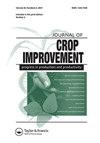利用光谱和图像数据以及形态特征对玉米特殊基因型的活/非活种子进行分类
IF 1.5
Q3 AGRONOMY
引用次数: 1
摘要
摘要种子活力是农业生产的一个重要考虑因素。通过新方法测量特种玉米基因型种子活力的研究数量有限。本研究旨在使用光谱测量和成像技术确定两个特种玉米(高油和高蛋白)群体的种子(n=950)的活力。来自种子胚胎的光谱数据是在1200和2400nm之间收集的。图像数据采用300 dpi分辨率拍摄。从收集的图像中,提取红色(R)、绿色(G)和蓝色(B)[RGB]数据,并确定形态特征(M)。然后,将种子样品分为两组,并使用两种不同的方法[标准发芽(SG)试验和三苯基氯化四氮唑(TTC)试验]测定样品的活力。使用支持向量机(SVM)、随机森林(RF)和分类与回归树(CART)方法开发分类模型(n=36)。SG检验(0.56–0.91)和TTC检验(0.53–0.85)的模型分类精度相当。然而,基于TTC检验结果的分类模型的敏感性(0.86–0.99)高于特异性值(0.07–0.74),这表明活种子比不活种子更准确地识别。基于SG检验(灵敏度=0.89,特异性=0.94,准确度=0.91),使用NIR+M数据集创建的RF模型对于确定本研究中使用的特种玉米基因型的种子活力最有效。本文章由计算机程序翻译,如有差异,请以英文原文为准。
Classification of viable/non-viable seeds of specialty maize genotypes using spectral and image data plus morphological features
ABSTRACT Seed viability is an important consideration for agricultural production. The number of studies on the measurement of seed viability in specialty maize genotypes via new approaches is limited. This study was carried out to determine the viability of the seeds (n = 950) of two specialty maize (high oil and high protein) populations using spectral measurements and imaging techniques. Spectral data from the seed embryos were collected between 1200 and 2400 nm. Image data were taken with 300 dpi resolution. From the collected images, red (R), green (G) and blue (B) [RGB] data were extracted, and morphological features (M) were also determined. Then, the seed samples were separated into two sets and the viability of the samples was determined using two different methods [standard germination (SG) test and triphenyl tetrazolium chloride (TTC) test]. Support Vector Machine (SVM), Random Forest (RF), and Classification and Regression Tree (CART) methods were used to develop the classification models (n = 36). Classification accuracy of the models was comparable for the SG test (0.56–0.91) and TTC test (0.53–0.85). However, the classification models based on TTC test results had higher sensitivity (0.86–0.99) than specificity values (0.07–0.74), which indicated that the viable seeds were more accurately identified than the non-viable seeds. The RF model, created using the NIR+M dataset, based on the SG test (sensitivity = 0.89, specificity = 0.94, accuracy = 0.91), was most effective for determination of the seed viability of specialty maize genotypes used in this study.
求助全文
通过发布文献求助,成功后即可免费获取论文全文。
去求助
来源期刊

Journal of Crop Improvement
Multiple-
CiteScore
3.30
自引率
7.70%
发文量
42
期刊介绍:
Journal of Crop Science and Biotechnology (JCSB) is a peer-reviewed international journal published four times a year. JCSB publishes novel and advanced original research articles on topics related to the production science of field crops and resource plants, including cropping systems, sustainable agriculture, environmental change, post-harvest management, biodiversity, crop improvement, and recent advances in physiology and molecular biology. Also covered are related subjects in a wide range of sciences such as the ecological and physiological aspects of crop production and genetic, breeding, and biotechnological approaches for crop improvement.
 求助内容:
求助内容: 应助结果提醒方式:
应助结果提醒方式:


